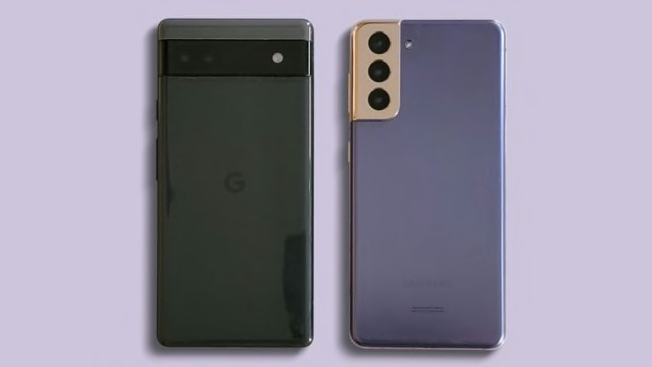Review: Google Pixel 6a
Google’s latest A-series smartphone has a new chip and last year’s $449 price, but is it worth buying?
When you shop through retailer links on our site, we may earn affiliate commissions. 100% of the fees we collect are used to support our nonprofit mission. Learn more.

With the Pixel 6a, Google proves once again that you don’t have to pay $1,000 to get a phone with a lot of features.
For less than half that price, the model comes with a clean and simple Android interface, a bright 6.1-inch OLED display, and not one but two rear cameras—a rarity for a moderately priced phone.
The Pixel 6a carries the same $449 price as last year’s 6.3-inch Pixel 5a. But it packs Google’s home-brewed Tensor chipset, the same brains found in the 6.4-inch Pixel 6 for $599 and the 6.7-inch Pixel 6 Pro for $899.
According to Google, Tensor enables the Pixel 6a to perform advanced AI and machine learning tasks—particularly for taking photos and videos—without taxing the battery as much as previous Pixel models.
Display and Design
At a glance, the Pixel 6a has more in common with the Pixel 6 and Pixel 6 Pro than the Pixel 5a.
It features the series’ two-tone back with the distinctive rear bar housing the primary and ultrawide cameras. The bar isn’t as thick as the one on the Pixel 6, though, which helps the smaller phone feel less top-heavy.

Photo: Melanie Pinola/Consumer Reports Photo: Melanie Pinola/Consumer Reports
Even though the 6.1-inch Pixel 6a is more compact than the Pixel 5a and Pixel 6 (both are 6.4 inches, measured diagonally), the difference isn’t really noticeable until you use the phones side-by-side. The Pixel 6a is easy to grip and operate one-handed, thanks in part to the slightly curved matte aluminum sides.

Photo: Melanie Pinola/Consumer Reports Photo: Melanie Pinola/Consumer Reports
In terms of build quality, the Pixel 6a is made with fewer premium materials: a Gorilla Glass 3 front panel vs. the Pixel 6’s tougher Gorilla Glass Victus, and a “3D thermoformed composite back” instead of Gorilla Glass 6. The plastic back is easy to smudge with fingerprints, marring the model’s pristine look, but you should tuck it in a case for protection anyway.
The OLED display has the same 60Hz refresh rate as the Pixel 5a, which may disappoint some people. The $450 Samsung Galaxy A53, for example, has a large 6.5-inch display with a 120Hz refresh rate, and that higher refresh rate makes for speedier scrolling and animations, although a lower one may help conserve battery life.
Despite the low refresh rate, the Pixel 6a didn’t stutter while I was tapping through screens and photo galleries, nor while I was moving settlers around in Civilization VI. The phone’s display was also bright enough to use outdoors on a cloudless day without straining my eyes.
In CR’s labs, the phone earned a Very Good score for performance—which takes into account ease of use and processing speed—and for its display quality.
Battery Life and Charging
Because of the dip in size, the Pixel 6a has a smaller battery than the Pixel 5a: 4,400 mAh vs. 4,610 mAh.
The Pixel 5a logged 43.5 hours on a single charge in CR’s battery life tests. The Pixel 6a lasted just 30.5 hours. That’s enough for a full day of work and then some, but still below average for smartphones these days. And so the 6a ranks just a hair below its predecessor in CR’s smartphone ratings.
The Pixel 6a supports fast charging up to a speed of 18 watts. That’s the same as last year’s model and much slower than the 65-watt charging on the OnePlus 10 Pro 5G for $900. But it’s not a problem unless you’re prone to letting the battery on your phone run down right before an important call or videochat.
More significant perhaps is the Pixel 6a’s lack of support for wireless charging. It’s not a common feature in midpriced phones (with the exception of Apple’s iPhone SE), but I’ve come to enjoy the convenience of simply setting my phone down on a charging pad without having to fuss with a wire.
Cameras
Like the Pixel 5a, the Pixel 6a has two rear cameras: a 12.2-megapixel option with a wide lens and a 12-megapixel option with an ultrawide lens. There’s an 8-megapixel selfie camera, just like the one on last year’s model, but that’s modest compared with most models we test (though the front camera on the iPhone SE is only 7 megapixels). The one on the OnePlus 8T, $400, is 16 megapixels, for example.
But that hardware tells only part of the story. Unlike the Pixel 5a, the Pixel 6a can harness the Tensor chip to take software-enhanced photos and videos.
The Magic Eraser—my favorite feature—allows you to strip passersby, photo bombers, and random objects from your photos in a way that truly feels like wizardry. Despite my average photography skills, I was able to use it to quickly and easily improve my shots after the fact.

Photo: Melanie Pinola/Consumer Reports Photo: Melanie Pinola/Consumer Reports
Other camera tricks include Blur, which you can use to soften the background, and Color Focus, which changes the saturation of a photo. Working in the background, the software can sharpen or “unblur” faces and capture more accurate skin tones, according to the company.
The Pixel 6a also has Night Sight, which helps you capture photos in low light without the flash. It’s not perfect—the resulting images have a very soft focus—but the camera works remarkably well given the conditions. Here’s a photo of a stuffed animal taken in a completely dark room (and by dark, I mean I needed to use the phone’s flashlight to avoid bumping into the furniture).

Photo: Melanie Pinola/Consumer Reports Photo: Melanie Pinola/Consumer Reports
Unlike the Pixel 6 and 6 Pro, though, the 6a doesn’t have Motion Mode, which can add focus to a moving subject, such as a kid on a bicycle or a cat climbing a tree. It can blur the background or the subject, depending on the effect you prefer.
In less-than-ideal lighting situations, some of the photos I took with Portrait Mode came out grainier than they did with the Pixel 6’s camera. But overall, I found the Pixel 6a’s camera capabilities to be impressive, especially given the price.
CR testers say the cameras are among the top performers for shooting stills, selfies, and videos.
Pixel 6a vs. Pixel 5a vs. Pixel 6
A Pixel phone is a no-brainer if you like the purity of the stock Android experience—a clean and simple interface without the extra apps and add-ons that manufacturers like Samsung and OnePlus layer on top of the operating system.
And if you already own a Pixel, the 6a’s new camera tricks and other AI-assisted capabilities—think real-time, offline translation (Live Translate)—might be tempting. You also get five years of guaranteed security updates, Google says. (The Pixel 5a, in contrast, is eligible for just three years’ worth.) In processing power alone, the Pixel 6a is a step up, too.
But before you buy it, you should take a quick look at the Pixel 6. During Amazon Prime Week, the price for that model fell to $450. And right now it’s on sale at Best Buy for $500. That gets you wireless charging, a slightly bigger display with a faster refresh rate, more RAM (8GB for the Pixel 6 vs. 6GB for the 6a), and better rear and front cameras.
















